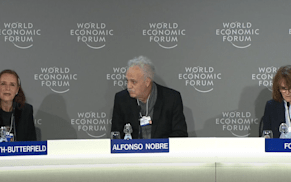This month at the World Economic Forum Annual Meeting in Davos, Science Panel for the Amazon (SPA) Co-Chair, Carlos Nobre, presented at two panels that centered around climate change in the Amazon region. The Annual Meeting Convenes leaders from government, business, and civil society to address the state of the world and discuss priorities for the year ahead. It provides a platform to engage in constructive, forward-looking dialogues and help find solutions through public-private cooperation.
The first panel, How AI Helps Fight Wildfires, centered around tools that assist in prediction of wildfires in order to combat their spread. Dr. Nobre spoke alongside Cathy Foley who is Australia’s Chief Scientist. The moderator began by asking, are fires in the Amazon mostly natural or human-caused? Dr. Nobre started the presentation by highlighting that tropical forests are the only biome in which the ecological evolution over tens of millions of years did not allow fires to spread due to them being closed canopy. Four percent of solar radiation reaches the forest floor and the dry season is very short. There is rain even during the dry season so the soil is very wet year round. The rainfall systems in the Amazon have “green ocean clouds,” meaning the clouds over the ocean are lower and shallower, so there are fewer lightning strikes compared to other biomes. Even when lightning strikes in the Amazon, the ground matter is so wet, that it only propagates a few meters. Even when there is a serious drought, there might be a large-scale fire, but this drought would only occur once or twice per century, so the forest would have sufficient time to regenerate.
Therefore, with this knowledge, we know that fires in the Amazon are all human made, unlike Australia, the western US, and other fire prone areas. He then explained that in tropical Latin America, 95% of fires are caused by humans because fires are used as an extension for agriculture (livestock farming and pastures for cattle). Climate change and increased frequency of extreme droughts, combined with human made fires, has resulted in wildfires increasing tremendously in the Amazon. From 2003-2018, 150,000 square kilometers of forest burned. Though droughts contributed to this, it was mostly due to runaway fires from cattle farmers clearing land. The Amazon has 6.5 million square kilometers of forest and 1 million square kilometers of that is already degraded. We are seeing yearly increases in fires due to this, which never happened before in the millions of years of the Amazon’s history and evolution. Dr. Nobre stated that 33 years ago, he along with other scientists produced a paper predicting that the Amazon would start turning into a degraded ecosystem. This is no longer just a prediction, as we are currently seeing the effects of degradation in regions that are hitting the tipping point. He also added that the southern part of the Amazon, unlike most forests on the planet, has become a carbon source due to severe degradation. His opinion on using AI for predicting wildfires in Latin America, due to 95% of wildfires coming from illegal methods, is that it would be a positive tool. He ended by highlighting the importance of Indigenous stewardship and pointed out how, for over 12,000 years, Indigenous peoples used fire for agriculture, while also prioritizing the conservation of land. They did this by using fire in a small area for agriculture for only 25 years or so and then they would abandon the land so that it could regenerate. Interestingly, due to the threats of other methods of fire increasing, Indigenous peoples in the Amazon no longer use fire for agriculture.
The second panel, The Amazon at a Crossroads, centered around strengthening collaboration and enabling the bioeconomy of the Amazon to deliver sustainable benefits for people and the planet. Dr. Nobre spoke alongside Brazil’s Minister of the Environment and Climate Change Marina Silva, Colombia’s Minister of Environment Maria Susana Muhamad, Governor Helder Barbalho of Pará, and social entrepreneur Derek Gallo. The moderator, CEO of the Nature Conservancy Jennifer Morris, began by emphasizing how the Amazon is a global public good and that in 2021 alone, we lost a portion of the Amazon that is half the size of Switzerland.
Dr. Nobre presented on the severity of the tipping point in the Amazon and emphasized the solutions found in the Science Panel for the Amazon publications. He covered how the dry seasons are happening 4-5 weeks longer than normal and how the southern portion has become a carbon source, climate change and land-use change being the main drivers. Dr. Nobre was then asked what should be the first action of the new government in the Amazon to save the region. He responded by stating that all Amazon countries need to move quickly, pointing to SPA’s main recommendation to get to zero deforestation and zero degradation immediately, the key to saving the Amazon.
Marina Silva followed Dr. Nobre by stating her priorities as Minister of the Environment and Climate Change, noting her previous experience as Minister of the Environment in 2003 in reducing deforestation by 83%. She stated that the new government will have strong partnerships and new agencies to ensure that protection of the Amazon rainforest is a top priority, with an upcoming summit with President Silva and leaders of the Amazon countries in order to create a unified strategy.
The panel ended with a Q&A where Dr. Nobre was asked if carbon credits are a “dead end” and he responded stating that, if done correctly, they are good traceability systems and he is very optimistic that removal of carbon can have an economic value. It’s not the only method, but it is an important tool to help the forest, particularly to create a large-scale forest restoration project (for which $20 billion is needed).

